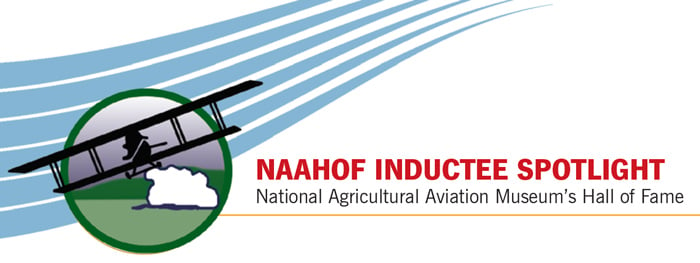INDUCTED — 1984
Began organized agricultural flying in 1926 in Mississippi and formed one of the first commercial firms in Clarksdale, Mississippi, 1933.

Biography
Dock Dockery began his aviation career soloing at the tender age of 12, September 12, 1921! Albeit quite by accident, Dock had flown with barnstorming pilot, Barney Flowers, as a passenger in a Standard with a four-cylinder Hall-Scott engine. Dock had been hired to guard the aircraft while in Corpus Christi, Texas. In payment for his services, Flowers took Dock on a cross-country through southern Texas, where Dock “followed through on the controls”, but never flew the aircraft.
Back in Corpus Christi, while guarding the ship, upon a dare by his brother Alfred, Dock proceeded to taxi the Standard in the pasture, when it took flight! Dock flew around for about ten minutes, then proceeded to land in the pasture, when the last drop of fuel passed through the carburetor! Dock’s first flight was also a dead stick landing. Landing safely, from that moment on Dock Dockery was hooked on flying.
Dock went to work for the next two years spotting fish with the Standard he had soled. He flew 600 hours and to his knowledge that most likely was the beginning of fish spotting by aircraft.
In 1923, at the age of 15, Dock moved to Pine Bluff, Arkansas. In nearby Stuttgart a blacksmith, by the name of Dick Shelburn, built-up Hisso Standards to sell. When Shelburn’s regular ferry pilot wasn’t available, young Dock took the job of flying a Standard to its new owner in Jackson, Mississippi. After that Dock continued flying for Shelburn, but got discontented and moved on.
Moving to Capital Hill, Oklahoma to work for Burl Tibbs as a flight instructor, Dock trained the likes of Benny Howard, Wiley Post, Paul Braniff, along with other notable future aviation pioneers. Dock is even credited with checking out for night flying, his friend Charles Lindberg. Only problem working for Tubbs was that he took the credit for the training. Dock returned to Stuttgart.
In 1926 Jimmy Finklea of Leland, Mississippi came to Stuttgart in a Standard SJ with a Hisso engine to take flying lessons. He told Dock and Allen Scott about a heavy leaf worm outbreak at the Delta and Pine Land Planting Company at Scott, Mississippi. Dockery and Scott convinced Finklea to allow them to install a duster hopper in the Standard.
They flew the Standard to Mississippi where the worms were defoliating the cotton, loaded the hopper with calcium arsenate and flipped a coin to see who would fly the first load. Dock won, took off and flew low over the cotton, opening the hopper gate. Because there was no sealing, most of the dust ended up in the cockpit, blinding Dock!
Actually, conditions for dusting were perfect and the two pilots managed to finish, getting perfect results.
Dock maintained an operation in his hometown of Stuttgart, but also formed a company in Clarksdale, Mississippi in 1933 working for King and Anderson Planting Company, one of the largest cotton producers in the world.
Dock’s aircraft were Waco 9s, Travel-Airs, Stearman C3Bs, and one famous “Bull” Stearman with a 330 horsepower J69. It could carry 1,000 pounds! The aircraft was Dock’s favorite. One day near Moorhead City, Mississippi Dock was forced to park it in the top of a tree due to an engine failure. The Finklea Brothers bought the “Bull” Stearman in the tree, took it down and soon had it back to flying.
Dock was successful at spreading aerial application to other crops besides cotton. Although rice may have been seeded by air first in California, Dock certainly introduced it to the southern rice growing regions around and in Arkansas. The first successful seeding Dock did for rice was on the Paul Wollworth Farm near Stuttgart in 1938.
Dockery also pioneered aerial applications in the Midwest, particularly in the vegetable growing regions of Wisconsin, Illinois and Minnesota.
Dock also pioneered aerial applications in the Midwest, particularly in the vegetable growing regions of Wisconsin, Illinois and Minnesota. With an outbreak of aphids in peas in Reedsburg, Wisconsin, Dock applied rotenone dust at 40-50 pounds to the acre for the sum of five cents pound, a fortune in those days. Soon afterwards, Dock contracted with Green Giant Foods and the pilgrimage to the north country became a regular source of income. Dock also made annual migrations to the southeastern shore of New Jersey to dust the cranberry orchards, as early as 1931.
Jesse Orval “J.O. Dockery died in Navarre Beach, Florida in December 1997. Although his ag flying had ended many years earlier, he was still making a living flying until the last few years before his death. He was buried in Stuttgart, Arkansas. For a more complete history of Dock Dockery refer to AgAir Update’s October 1990 issue and Mabry Anderson’s Low and Slow.
JACKSON, MS — NAAHOF Inductees is a series of articles featuring the inductees to the National Agricultural Aviation Museum’s Hall of Fame. Although some of the information is limited, including in some cases unknown induction years, it is the best compilation available from The National Agricultural Aviation Museum, the NAAHOF Nominations Board of Directors, the NAA Museum Board of Directors and Mabry Anderson’s book, Low and Slow.
Each month AgAir Update will feature from one to several individuals honored in the National Agricultural Aviation’s Hall of Fame, how many depending on the information available about the individual. AgAir Update would like to express a sincere “Thank You” to Mabry Anderson, author of Low and Slow, from where much of this information came, the National Agricultural Aviation Museum and its staff, the NAAHOF Nominations Board of Directors, the NAAHOF Board of Directors, and Dick Reade, whose idea it was to originate this column. Enjoy reading about the history and the history makers of ag aviation:







